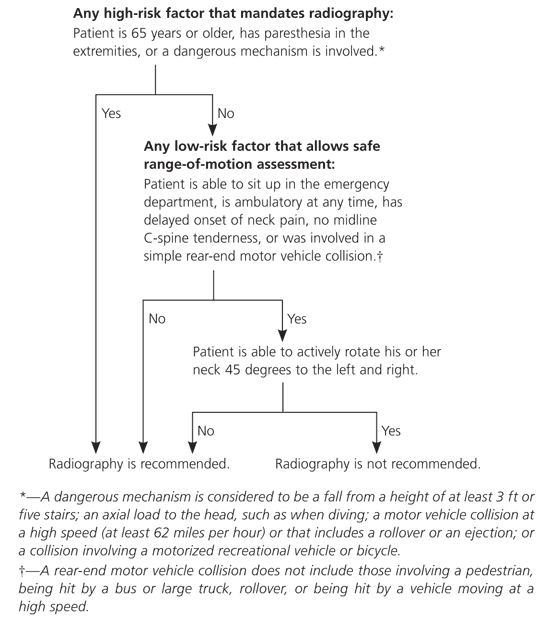
Am Fam Physician. 2006;73(10):1787-1788
Clinical Question
When is radiography indicated for patients with blunt trauma to the cervical spine (C-spine)?
Evidence Summary
Neck pain caused by blunt trauma from a motor vehicle collision, fall, or other injury is a common occurrence. Many patients who decline ambulance transport after an injury will present to their primary care physician rather than the emergency department. Two clinical rules have been developed and validated to help physicians determine which patients with blunt trauma to the C-spine need radiography to rule out fracture.1–3 The goal is to safely reduce unnecessary radiography without missing clinically significant injuries. Although the clinical rules were validated in the acute emergency department setting, with appropriate training they would be applicable in the outpatient primary care setting as well. A third clinical rule to predict C-spine fractures in patients 65 years or older was developed using a retrospective chart review4; however, it is not included in this article because it was not prospectively validated.
The National Emergency X-Radiography Utilization Study (NEXUS) low-risk criteria for C-spine radiography in patients with blunt trauma (Table 11 ) were developed and validated over a 10-year period.1 The largest of these prospective validation studies included 34,069 patients presenting to 21 U.S. health centers with blunt trauma who underwent C-spine radiography.3 Patients who did not have C-spine radiography or who had the test for reasons other than trauma were excluded. The study included a broad range of patients, the age range was one to 101 years, and intoxicated patients were included. The NEXUS criteria correctly identified 810 out of 818 patients (99.0 percent) with C-spine injury and 576 out of 578 patients (99.7 percent) with clinically significant injury. Of the latter two missed injuries, one was described in one report (but not in others) as an “extension teardrop” fracture; the patient refused treatment and was asymptomatic at six weeks. The patient with the second missed injury did not have neck pain but had a fracture at the right lamina of C-6 that eventually required laminectomy and fusion. The patient recovered well.
| Radiography is not recommended if a patient meets all of the following criteria: |
| Absence of tenderness at the posterior midline of the C-spine |
| Absence of a focal neurologic deficit |
| Normal level of alertness |
| No evidence of intoxication |
| Absence of clinically apparent pain that might distract the patient from the pain of a C-spine injury |
The Canadian C-Spine Rule2 (Figure 15 ) was prospectively validated in 8,283 Canadian patients; it also was compared to the NEXUS criteria in a large clinical trial.5 This study showed that, compared with the NEXUS criteria, the Canadian C-Spine Rule was more sensitive (99.4 versus 90.7 percent) and more specific (45 versus 37 percent) in its intended population. Although these findings seem to suggest that the Canadian C-Spine Rule is more accurate, there were several possible biases against the NEXUS criteria. The comparison study5 was conducted in the same hospitals and with the same physicians as the original Canadian C-Spine Rule study.2 The comparison study also used different wording for the NEXUS criteria than that used in its original study.1 In addition, about 10 percent of participants in the comparison study were not evaluated using the Canadian C-Spine Rule because physicians were afraid to move the necks of these patients. Finally, the comparison study population was very different from that in the original NEXUS population, which included children and intoxicated patients. The NEXUS criteria are simple to use and have been effective in the intended population; therefore, the NEXUS criteria are still a valuable clinical tool.

Applying the Evidence
A 48-year-old man was bicycling in the country when his front wheel became embedded in loose gravel. He flipped over the handle-bars and landed on his head. The impact was partially absorbed by his arms, and he was wearing a helmet. He now complains of neck and head pain and has tenderness at the posterior midline of the C-spine. He is alert, is not intoxicated, and has no other significant injuries.
Answer: Using the NEXUS criteria, you determine that radiography is recommended because the patient has posterior midline tenderness. Using the Canadian C-Spine Rule, you determine that a bicycle collision or an impact involving an axial load to the head constitutes a dangerous mechanism; therefore, radiography is indicated for this patient.